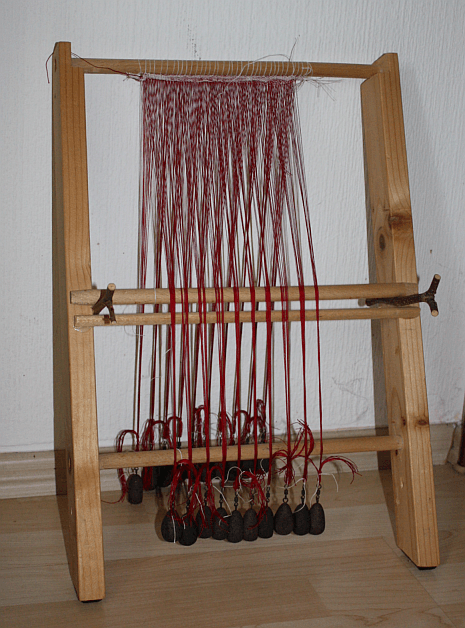Search the Blog
Latest Comments
Katrin
Spinning Speed Ponderings, Part I.
15. April 2024
As far as I know, some fabrics do get washed before they are sold, and some might not be. But I can'...
Kareina
Spinning Speed Ponderings, Part I.
15. April 2024
I have seen you say few times that "no textile ever is finished before it's been wet and dried again...
Katrin
How on earth did they do it?
27. März 2024
Ah, that's good to know! I might have a look around just out of curiosity.
I've since learned that w...
Heather Athebyne
How on earth did they do it?
25. März 2024
...though not entirely easy. I've been able to get my hands on a few strands over the years for Geor...
Katrin
Hieroglyphs.
23. Februar 2024
Yes, that would sort of fit that aspect - but you can also go from bits of woods to sticks if you ar...
More from the Mini-Loom, Part 2: Tensioning.
Next step for the loom setup was getting the weights... and there's another thing that does not scale down easily. I had looked for typical weight per thread numbers, but a quick search did not give me any conclusive data, there was no time for more than a really quick search, and so I basically fiddled around a bit with some items and the kitchen scales and then sort of decided on a weight per guesstimate.
Off into the fishing tackle shop, then. I had decided on 20 weights (10 per row) with about 65 g of weight, each tensioning a bundle of 11 threads - this means about 5 g of tension per thread, which, I hoped, would be easily sufficient for the smooth cotton warp.
The friendly man in the tackle shop informed me that there were 64 g weights available. They were not only available, but also in a sufficient quantity, and they were covered in a sort of camouflage paint (thus closing in the lead, much to my appreciation), and had a suitable form and shape - sort of pear-shaped, with two flattened sides. So I happily went out of the shop with my 20 weights. This part of the loom, by the way, is the most expensive part - the little bits of wood that it is made from were all scrap wood.
Back at the loom, it was bundling the threads of the front and back layer into bundles of 11 threads each (the last, obviously, of only 10 threads), tying them and attaching the weights. I chose to do the tying with a slipknot and then tied the weight in with a bit of linen thread.

You can see how it all hangs nicely in bundles, with almost all the weights at the same height. The weights give it a nice tension, and the whole thing is surprisingly heavy when you lift it - the small size of the weights is misleading to the eye.
Next step: Heddles... which was something that I sort of dreaded.
A lot.
Off into the fishing tackle shop, then. I had decided on 20 weights (10 per row) with about 65 g of weight, each tensioning a bundle of 11 threads - this means about 5 g of tension per thread, which, I hoped, would be easily sufficient for the smooth cotton warp.
The friendly man in the tackle shop informed me that there were 64 g weights available. They were not only available, but also in a sufficient quantity, and they were covered in a sort of camouflage paint (thus closing in the lead, much to my appreciation), and had a suitable form and shape - sort of pear-shaped, with two flattened sides. So I happily went out of the shop with my 20 weights. This part of the loom, by the way, is the most expensive part - the little bits of wood that it is made from were all scrap wood.
Back at the loom, it was bundling the threads of the front and back layer into bundles of 11 threads each (the last, obviously, of only 10 threads), tying them and attaching the weights. I chose to do the tying with a slipknot and then tied the weight in with a bit of linen thread.

You can see how it all hangs nicely in bundles, with almost all the weights at the same height. The weights give it a nice tension, and the whole thing is surprisingly heavy when you lift it - the small size of the weights is misleading to the eye.
Next step: Heddles... which was something that I sort of dreaded.
A lot.
Comments
No comments made yet. Be the first to submit a comment



